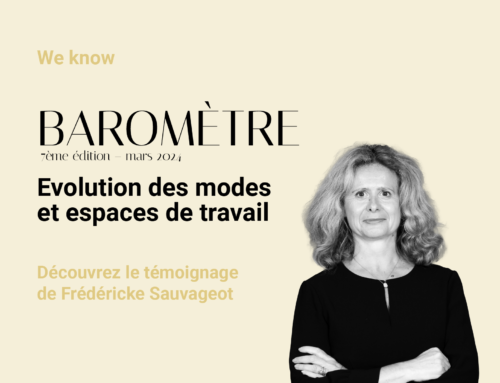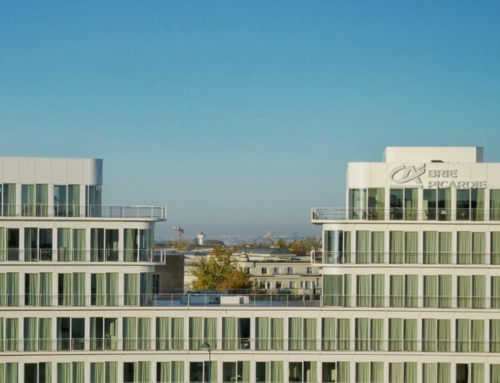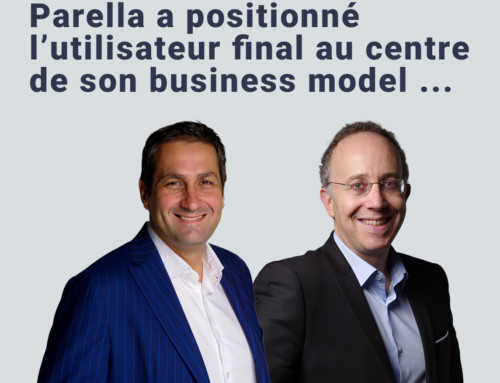Hybrid working: a better response to change
On December 05, MyRHline and I hosted a webinar on hybrid working, presenting the results of a survey conducted by CSA Research for Parella. A survey of 300 managers and 500 employees on the evolution of working environments.
Here is the feedback and learning from Coralie Delfosse, Director of HR Development & Transformation at Assurance Retraite Caisse Nationale (CNAV), Eve Laroudie, Executive Director in charge of Resources at Société du Grand Paris, and Diane Mendes, Manager of People and Transformation at Parella :

Telecommuting and hybrid working: a two-speed reality.
Three years after the health crisis, only 55% of employees have access to teleworking.
The situation varies greatly according to location and company profile: for example, the proportion of employees able to telework is :
- 69% in IDF versus 50% in the regions,
- 38% in small structures versus 62% in larger ones.
Yet telecommuting seems to have won over employees. Among those who have access to it, 3 profiles emerge: those who use it to the maximum of what is authorized (they are in the majority at 41%), those who come to the office every day except in exceptional circumstances (30%) and finally those who take advantage of the flexibility offered to them (29%).
Since the end of the health crisis, the number of authorized teleworking days and teleworking arrangements have not changed for 43% and 47% of employees respectively.In companies where things have changed, the number of days granted has increased for 37% of them, and the terms and conditions have become more flexible for 32%.
What do our guests have to say about teleworking?
Eve LavoudieEve Lavoudie, explains that before the Covid crisis, Société du Grand Paris had a 1-day/week telecommuting agreement in place, whereas after the lockdown, they went to 2 days/week, which was unavoidable given the habits that had been established..
As a result, telecommuting has become widespread among employees. There is no difference in the number of days teleworked depending on the position, function or job. Anyone can telework at home or in another part of the country, especially if they live outside the Ile-de-France region.
However, face-to-face work predominates, with an average of 1.6 days of telecommuting per week taken. And 42% of employees never take teleworking days.
Coralie Delfosse, shares that the CNAV and its network (Carsat, CGSS, CSS) have been engaged in thinking around teleworking for many years, including a first CNAV-wide agreement signed back in 2014. The CNAV and its network have not been exempt from the democratization and intensification of teleworking, with an average rate of 82% of teleworkers within the network.
At Caisse Nationale level, a new agreement has made the practice of teleworking more flexible, with a more empowering common law system characterized by an annual envelope of 100 teleworking days, which can be used according to the job and associated requirements, as well as occasional problems (transport strikes, bad weather, etc.). At the same time, a derogatory formula of three days a week has been introduced to maintain the attention paid to sensitive or fragile moments or situations: disability, caregivers, pregnant women, senior citizens, parents of young children, geographical remoteness...
This implementation is part of a strong conviction in the need for a well-thought-out telecommuting approach, striking a balance between on-site and remote working, between common rules and individualized work organization.
This choice has enabled us to rethink our premises to offer more collaborative spaces, once again enabling teams to gain in flexibility according to their uses.
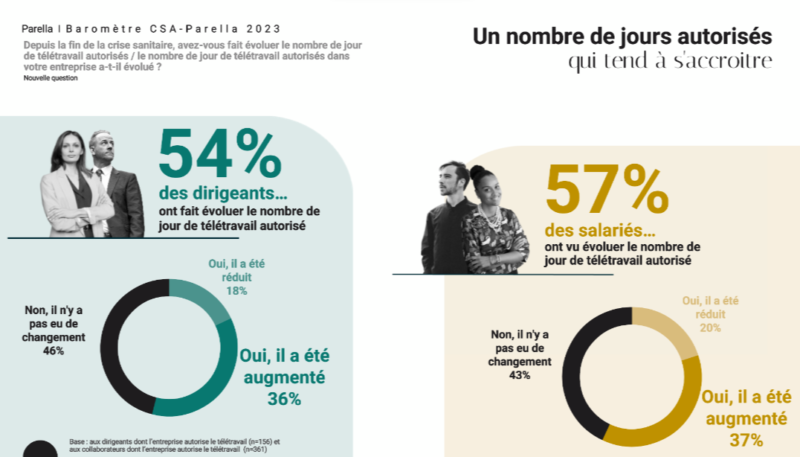
Flex-office appeals to employees because it encourages meetings and exchanges.
Offices are still the place to be for social interaction and efficiency at work
As in 2022, workspace design plays a role in employee well-being (91%) and performance (82%).
When asked about the most important issue in the implementation of hybrid working, the majority of employees answer tools (40%), expressing their day-to-day operational and functional needs. On the same question, managers' answers were evenly divided between management (33%), tools (30%) and employee support (30%), reflecting a more global vision of the subject.
Employees still enjoy coming to the office. If, as last year, they come to see their colleagues (social bond, 69%), this year they also come to work more efficiently (56%).
Workspace remains a powerful lever for attracting and retaining employees. 69% believe that a beautiful workspace is a decisive factor in helping employees to flourish in the office, and that it is a vector of image and a tool for internal communication that has an impact on the employer brand.
Often part of the hybrid work equation, the flex office remains stable compared to last year, and concerns a quarter of employees, who still appreciate it. Some 73% think it's a good thing. This figure rises to 81% in the Paris region and 76% among the under-35s.
What do our guests have to say about flex office and hybrid working?
Diane Mendes, explains that while adoption times vary from one context to another, those who practice them see the benefits.
At CNAV, we're currently redesigning our offices to incorporate more collaborative and alternative spaces. Coralie explains to us that the office of tomorrow is currently being rethought, with the aim of revisiting the work experience, particularly in terms of workspaces. To this end, an internal study has been carried out to understand the expectations and needs of employees.
Sharing moments with colleagues and collaborating with them emerged as a priority issue, as did the search for work comfort (equipment, ergonomics), or the need for spaces to isolate oneself. The appropriation of spaces and tools also involves thinking about how to collaborate (on site or remotely).
To support these reflections, CNAV is currently working on digital tools to facilitate their appropriation and offer employees the best possible digital experience.
At Société du Grand Paris, a project to facilitate mobility within the building had been launched before the confinement. The project to fit out the new head office included hybrid working equipment, with simple, easy-to-use tools. Everything was designed to enable staff mobility both in and out of the office.
To encourage collaborative working, the project also incorporated more open spaces. The premises were designed to be "flex ready", so as to offer living and working spaces that can be easily adapted to the needs of future teams. The latest internal barometer revealed that 95% of employees were satisfied with their working environment.
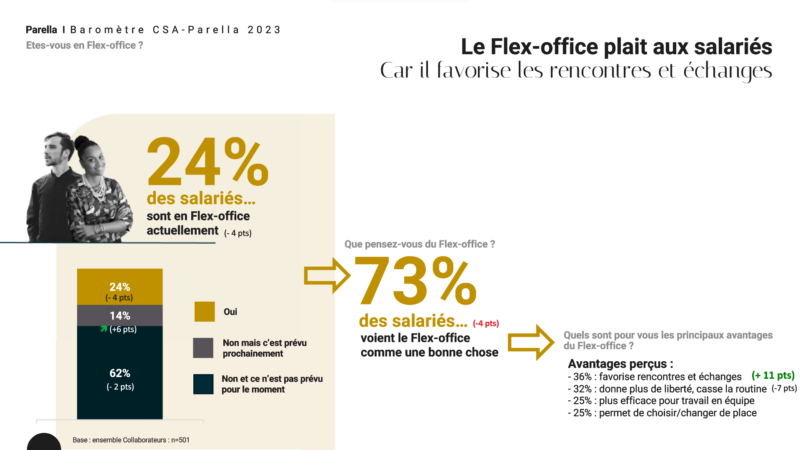
Workspace for the employee experience
As in 2022, workspace design plays a role in employee well-being (91%) and performance (82%).
Its impact on the company's image has even risen by 7 points according to employees, to 83%. Workspaces must embody the company's values and history (for 31% of employees), as well as its activity and products (for 28%).
Employees expect their companies to invest in the design of their workspaces. These investments should focus primarily on the QWL dimension of the workspace (81%), but also on its eco-responsibility (74%) and equipment (68%). It is worth noting that employees' expectations are significantly higher than managers' intentions (more than 10 points difference).
Another important aspect of the expected employee experience is the services offered to employees.Employees' expectations are still much higher than the services offered by managers. However, progress has been made on the catering offer, proposed by 35% of them, up 7 points on 2022.
What our guests have to say about telecommuting
Diane Mendes reminds us of the importance of clearly defining what will make the most sense for users and the company.
The employee experience is a key issue for Coralie Delfosse. In response, CNAV has developed a range of services, including crèche places for employees at sites in the Paris region, a media library and sports activities.
Eve Laroudieexplains that Société du Grand Paris' development is based on the company's values of "together, responsible, demanding". The question of QWL is very important to them.
Numerous tools and services are offered to our employees and form part of the working environment. Among the most popular are a gym and a nap room. The company also offers a concierge service and a company restaurant. Since telecommuting has become more widespread, SGP has scaled back its concierge services, as there is less need for them. However, the CSR dimension, and in particular sustainable development, has taken on greater importance, with greater use of bicycles, for example, and the need to make it easier for cyclists to get around (parking spaces, maintenance service, sustainable mobility package, etc.), as well as attention to the quality of catering and the entire food chain.
For both CNAV and Société du Grand Paris, eco-responsibility is at the heart of the company's business: it involves mobility and waste sorting and recycling.
It's not just a question of spaces and their building footprints, according to Coralie. It also raises the question of the carbon footprint of travel, the role of meat in seminar organization, and how to support employees on these issues, who also have a lot to contribute on the subject.
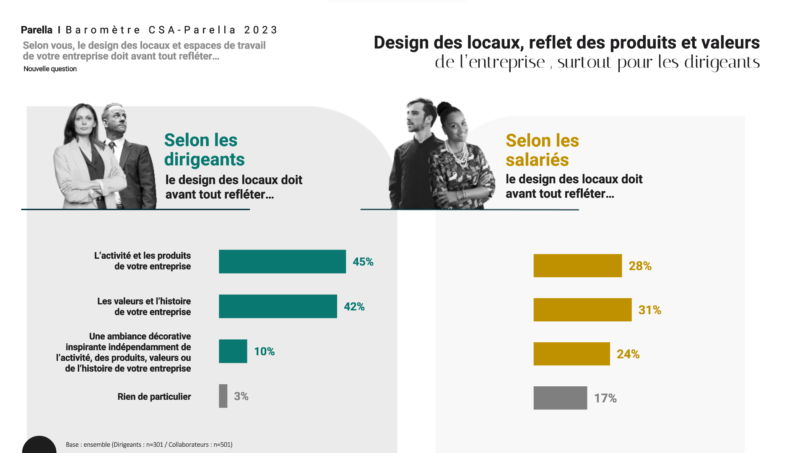
Are you ready to try out new ways of working?
Nearly 3/4 of employees would appreciate a 4-day week, while less than 1/4 of managers would be willing to try it out.41% of employees would be delighted to be able to live where they want, while less than one in five managers would be prepared to test this.
At CNAV, sensible teleworking has always been the objective, and 100% teleworking is not envisaged. As for the 4-day week, it has been tested with around twenty employees for over 8 months, and will be extended over the coming months in light of the initial positive feedback. However, the idea is not so much to make it the norm, but rather to offer an additional possibility of personalization in terms of work organization.
For Société du Grand Paris, discussions are focusing on the renegotiation of a telecommuting agreement following the experience of the last 2 years post-confinement. The company will also be gradually introducing flex working, an expectation that has been naturally expressed by employees for reasons of operational efficiency.

